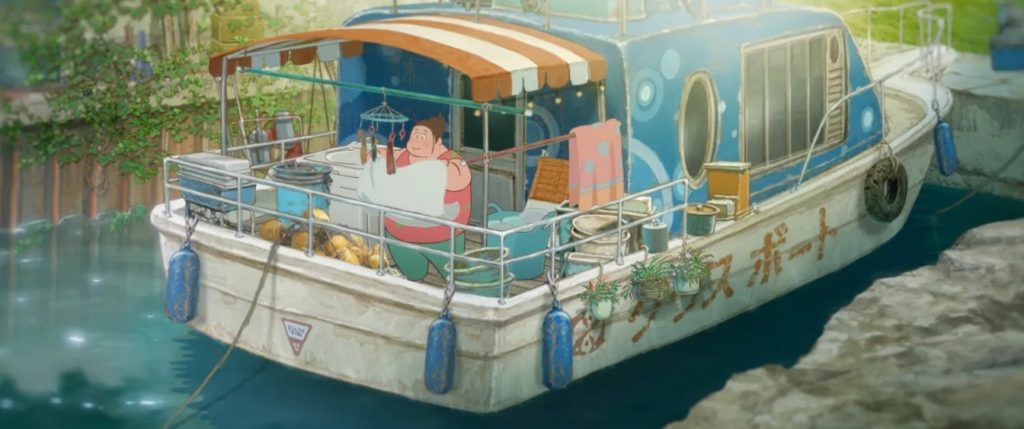Fortune Favors Lady Nikuko
August 24, 2023 · 0 comments
By Andrew Osmond.

Fortune Favors Lady Nikuko is a rare kind of anime, a stand-alone film that presents daily life in the manner we’re more used to in TV series. In this case, it’s the daily life of an eleven-year-old girl, Kikuko, living in a quiet port town under unusual circumstances. Her home is a moored boat, but what’s really unusual is her mother. Nicknamed Nikuko, she’s a manically cheerful giant whose noisy jollity can be maddening.
Nikuko busts the film’s animated “reality.” While Kikuko and most of the other characters are drawn in a delicate, generally realistic style, Nikuko is far more simplified and cartoony, as if she’s been transposed by magic from an entirely different film. The dissonance clues us in that we’re being shown Nikuko as seen by her daughter, though by the end, the giant has taken on more realistic dimensions. (In particular, look at the film’s very last shot before the credits roll.)
The film was directed by Ayumu Watanabe, who’s one of those anime directors who’s refused to be pigeonholed in the course of a decades-long career. As such, he’s like Gisaburo Sugii or Keiichi Hara. He’s directed series as diverse as Space Brothers, After the Rain and Mysterious Girlfriend X. More recently he helmed the time-loop-horror Summer Time Rendering, streaming on Disney+ as of writing, and was the Chief Director on the school romcom Komi Can’t Communicate.

In production terms, Nikuko has links to Watanabe’s earlier Children of the Sea, released two years before. Both films share the same studio – Studio 4°C – and the same Chief Animation Director, Kenichi Konishi, who was a mainstay of Ghibli and Satoshi Kon anime. The films also share the same art director, Shinji Kimura, whose career ranges from Angel’s Egg to Dorohedoro.
But while Watanabe’s films have obvious links – a sympathetic girl’s-eye view, sun-drenched, gorgeous coastal scenery – Nikuko is vastly different from Watanabe’s earlier mystical epic. Watanabe himself has suggested in interviews that Nikuko’s vital extra ingredient was the film’s producer, Sanma Akashiya. He’s not well-known in Britain, but in Japan he’s massive; he’s been a star comedian since the 1980s, and has been compared to Takeshi Kitano in terms of prominence.
Watanabe explained to Anime News Network that there were initially talks about developing Nikuko’s source novel – written by Kanako Nishi – in live-action. However, Sanma decided it would work better in animation, which is how it came to Studio 4°C and Watanabe. “Of course, Sanma-san is a figure that I knew very well from watching on TV as a very impressionable teenager,” Watanabe said. “So to have him right there in front of me and to be able to converse with him was a wonderful experience.”

The director added more about Sanma’s involvement in an interview for Cinema Daily. “He was there from developing the script, checking the script, and reviewing the storyboard. Especially with the recording, he was there most of the time, and, even during recording, he would suddenly come up with these jokes as an ad lib and incorporated them. This film really has a lot of the essence of Sanma-san in it.”
Watanabe was also open about one reason why Nikuko ended up being animated. “If a human actress depicted Nikko’s characteristics, the specifics would be too harsh for the actor and wouldn’t bring out Nikuko’s character. So (Sanma) thought, ‘Okay, maybe I could just do this in anime.’”
This brings up the reason why some viewers find Nikuko uncomfortable. Nikuko’s size, her obesity, is treated throughout the film as a source of humour – she is, quite frankly, a cartoon of fatness. Her size is presented as something that’s impossible to ignore – though it’s also clear this is how she’s seen by her eleven-year-old daughter.

In truth, it’s much less common to see plus-sized people in Japan (barring foreigners and sumo wrestlers) than in America or Britain, meaning someone like Nikuko would stand out all the more. Defenders of the film can argue that humour is not the same as mockery, and that the film’s whole point by the end is that it isn’t shaming Nikuko, but rather shaming viewers who judge her for how she looks. Animation as a medium revels in unusual, exaggerated shapes; that doesn’t make that revelry cruel.
Watanabe himself claimed to Anime News Network that he used animation “to emphasise the humour and how adorable (Nikuko) is over reality.” He framed Nikuko differently in an interview with Looper. “Speaking about characteristics of Nikuko, when you think about fantasy stories — if you think about, let’s say, fairies or kaiju monsters — there are a lot of chubby characters. I wanted to have Nikuko be a part of that — like someone who perhaps doesn’t exist in real life, but you would like (them) to. I really wanted to depict that with Nikuko.”
Within the film, Nikuko is overtly compared to one of the most beloved anime “monsters” of all – Totoro, created by Hayao Miyazaki. I’d argue, though, that Nikuko is more in the tradition of Miyazaki’s colleague Isao Takahata, and that you could take it as a playful reply to Takahata’s 1991 film Only Yesterday. That also used contrasting drawn styles, and involves loose, overlapping anecdotes about a preteen girl’s life at school and home. It’s true that Nikuko recalls Totoro; both give children support and succour. But Nikuko also reflects a child’s gaze, and not just in ways that are nice and cosy. That’s something that Takahata would have surely applauded.
Andrew Osmond is the author of 100 Animated Feature Films. Fortune Favors Lady Nikuko is released in the UK by Anime Limited.
Andrew Osmond, anime, Ayumu Watanabe, Fortune Favors Lady Nikuko, Japan, Sanma Akashiya
Leave a Reply